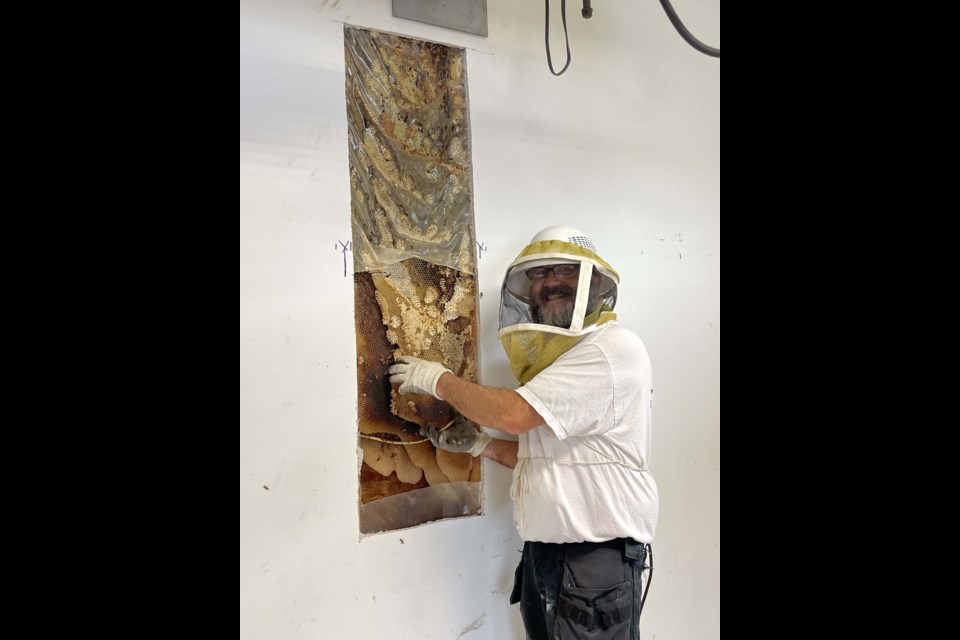STURGEON COUNTY - A swarm of some 50,000 honeybees is now in Edmonton after being removed from the walls of a Sturgeon County garage.
Sturgeon County resident Debbie Stahn posted on Facebook last week about her work with Edmonton beekeeper Jean-Charles Poirier to remove some 50,000 honeybees from her Namao-area garage.
Stahn said her acreage has a garage her family uses for storage. Last fall, she noticed honeybees flying around an exhaust pipe sticking out of the back of the garage, and determined that a colony had moved into the walls.
“They were really buzzing last year,” Stahn said of the bees.
Concerned for the bees’ safety, Stahn reached out to Poirier online for advice.
Poirier said he advised Stahn to leave the bees alone for the winter, as he wasn’t sure the colony would have time to rebuild its honey reserves if he were to relocate it. (A colony needs about 100 pounds of honey to survive the winter.) Stahn did not see bees around the garage come spring, suggesting that the colony had died or left.
Stahn said she contacted Poirier again on June 30 when the bees returned. On July 4, Poirier arrived with his equipment to extract the colony.
Poirier said he used a stethoscope to confirm that there were bees in the garage walls — the buzzing was audible. He then cut a hole in the drywall to reveal the hive, which turned out to be about 5.5 feet long, 16 inches wide, and about five layers deep.
Poirier said the hive was likely several years old based on the state of its combs. Based on the sparse honey reserves and the small number of eggs and larvae in the hive, he theorized that the hive had had hosted at least three colonies: the one Stahn saw last fall, which died; a group of bandits that raided the hive for its honey after; and the current swarm, which likely moved in about a week previous.
Poirier said he used a knife to cut the combs loose from the wall and a modified vacuum to suck up the bees. He collected about nine pounds of bees, which works out to about 50,000 to 75,000 bees, and two picnic-cooler-loads of comb.
Stahn said it was amazing to see so many bees in one place.
“It was like, oh my gosh, there’s so many in there.”
While honeybee swarms are normally pretty docile, as the bees are loaded down with honey, Poirier said they can become aggressive when their hives are attacked, as happened when he started cutting this one up.
“I did get stung 20-plus times,” he said, mostly on his hands.
Handling a hive
Poirier said he eventually secured the hive’s queen (who had retreated to the garage’s outside wall with about a thousand followers) in a queen cage, which resembles a transparent plastic hair clip. The queen and her colony were now living in bee boxes in his backyard and would soon move to their new home near Lac Ste. Anne.
“They have surprised me in every way,” he said of the bees, as they have managed to fill their boxes with honey, combs, and eggs in less than a week.
This particular bee colony was likely an offshoot of a commercial one which swarmed, which happens when a colony grows big enough to split in two, explained St. Albert beekeeper Malcolm Connell, who is often called in to wrangle wayward bees in the St. Albert region. Honeybee swarms often move into old buildings — he has a shed that hosts a swarm almost every year — while bumblebees tend to set up shop in birdhouses.
Connell said anyone concerned about a swarm of honeybees in their area can call one of the Edmonton District Beekeeping Association’s swarm-catchers to secure the bees.
“Swarms can leave at any time,” he noted, and many will simply fly away if you wait 20 minutes.
Connell and Poirier said residents should generally leave active hives on their property alone unless they are in areas you use frequently. Although abandoned hives can rot and attract pests, Poirier said active ones are harmless unless disturbed.
“I would encourage most people to live with the bees,” Poirier said.




